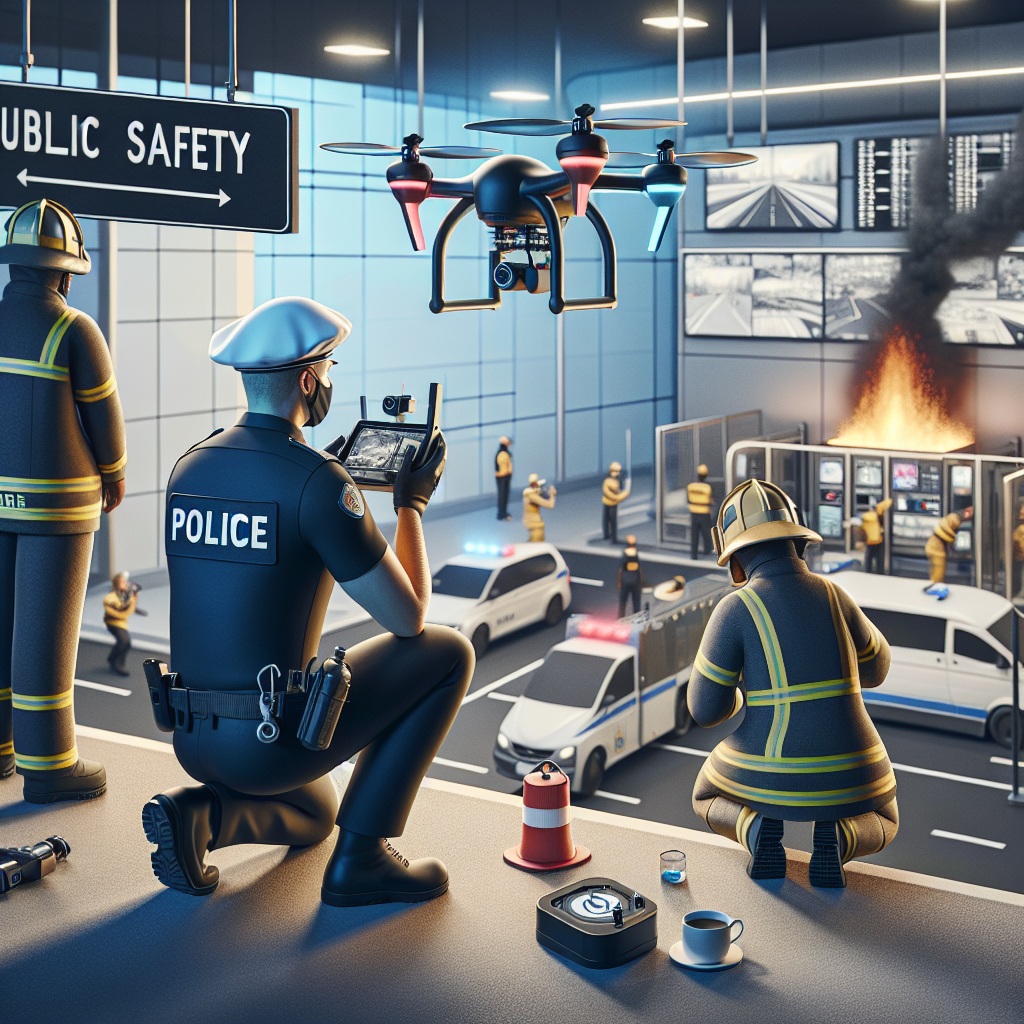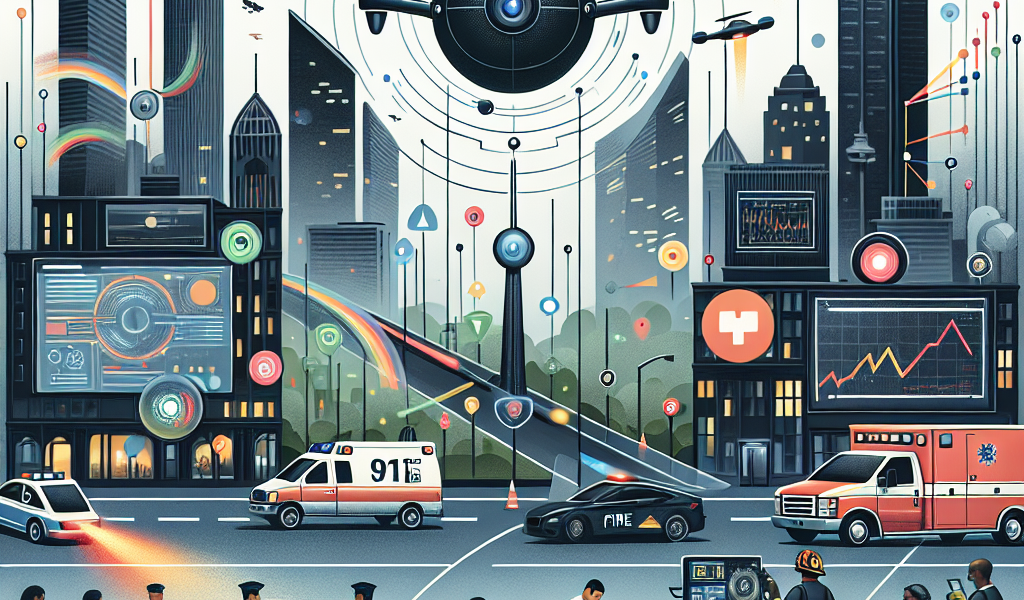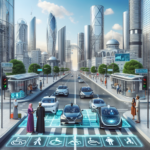-
Table of Contents
“Empowering Communities: Technology’s Pivotal Role in Public Safety”
Introduction

The Role of Technology in Enhancing Public Safety
In an increasingly interconnected and digital world, the role of technology in enhancing public safety has become paramount. From advanced surveillance systems and predictive analytics to emergency response applications and cybersecurity measures, technological innovations are transforming the way public safety agencies operate. These advancements not only improve the efficiency and effectiveness of law enforcement, emergency services, and disaster response teams but also empower communities to participate actively in their own safety. By leveraging cutting-edge tools and data-driven strategies, technology is helping to create safer environments, mitigate risks, and respond more swiftly to crises, ultimately fostering a more secure and resilient society.
The Impact of Artificial Intelligence on Crime Prevention
Artificial intelligence (AI) is revolutionizing various sectors, and its impact on crime prevention is particularly noteworthy. As technology continues to advance, law enforcement agencies are increasingly leveraging AI to enhance public safety. This transformation is not only making communities safer but also reshaping the way crime prevention strategies are developed and implemented.
One of the most significant contributions of AI to crime prevention is its ability to analyze vast amounts of data quickly and accurately. Traditional methods of data analysis are often time-consuming and prone to human error. However, AI algorithms can sift through enormous datasets, identifying patterns and trends that might otherwise go unnoticed. This capability allows law enforcement agencies to predict potential criminal activities and deploy resources more effectively. For instance, predictive policing models use historical crime data to forecast where crimes are likely to occur, enabling officers to be more proactive rather than reactive.
Moreover, AI-powered surveillance systems are enhancing the ability to monitor public spaces. These systems use advanced image and video recognition technologies to detect suspicious behavior in real-time. By analyzing footage from security cameras, AI can identify unusual activities, such as loitering in restricted areas or the presence of unauthorized individuals. This real-time analysis enables law enforcement to respond swiftly to potential threats, thereby preventing crimes before they happen. Additionally, AI can assist in the identification of suspects by matching facial features with criminal databases, streamlining the investigative process.
In addition to surveillance, AI is also playing a crucial role in cybersecurity. As cyber threats become more sophisticated, traditional security measures are often insufficient. AI-driven cybersecurity solutions can detect and respond to threats more efficiently than human analysts. These systems continuously monitor network traffic, identifying anomalies that may indicate a cyber attack. By doing so, they can mitigate risks and protect sensitive information from being compromised. This is particularly important for critical infrastructure, such as power grids and financial institutions, where breaches can have far-reaching consequences.
Furthermore, AI is aiding in the fight against human trafficking and exploitation. Machine learning algorithms can analyze online data to identify patterns associated with trafficking activities. For example, AI can scan social media platforms, classified ads, and other online forums to detect signs of exploitation. This information can then be used to locate victims and apprehend traffickers. Organizations dedicated to combating human trafficking are increasingly relying on AI to enhance their efforts, making it a powerful tool in the fight against this heinous crime.
Despite these advancements, the integration of AI in crime prevention is not without challenges. Privacy concerns are at the forefront of the debate, as the use of AI-powered surveillance and data analysis raises questions about the potential for misuse and overreach. It is essential for policymakers to establish clear guidelines and regulations to ensure that AI is used ethically and responsibly. Balancing the benefits of AI with the need to protect individual privacy will be crucial in gaining public trust and acceptance.
In conclusion, the impact of artificial intelligence on crime prevention is profound and multifaceted. From predictive policing and real-time surveillance to cybersecurity and combating human trafficking, AI is enhancing public safety in ways that were previously unimaginable. As technology continues to evolve, it is imperative that law enforcement agencies, policymakers, and the public work together to harness the potential of AI while addressing the ethical and privacy concerns that accompany its use. By doing so, we can create safer communities and a more secure future for all.
How Drones Are Revolutionizing Emergency Response
In recent years, the integration of technology into public safety measures has seen remarkable advancements, with drones emerging as a pivotal tool in revolutionizing emergency response. These unmanned aerial vehicles (UAVs) are transforming the way first responders approach critical situations, offering a bird’s-eye view that was previously unattainable. As a result, drones are not only enhancing the efficiency of emergency operations but also significantly improving the safety of both responders and the public.
One of the most notable applications of drones in emergency response is in search and rescue missions. When time is of the essence, drones equipped with high-resolution cameras and thermal imaging technology can quickly cover vast areas, identifying missing persons or stranded individuals in challenging terrains. This capability is particularly beneficial in natural disasters such as floods, earthquakes, or wildfires, where traditional search methods may be hindered by hazardous conditions. By providing real-time data and visual feedback, drones enable rescue teams to make informed decisions swiftly, thereby increasing the chances of a successful outcome.
Moreover, drones are proving to be invaluable in assessing disaster-stricken areas. In the aftermath of a calamity, the immediate priority is to evaluate the extent of damage and identify the most affected regions. Drones can be deployed to capture detailed aerial footage, offering a comprehensive overview that aids in prioritizing response efforts. This rapid assessment not only accelerates the delivery of aid but also minimizes the risk to human life by reducing the need for ground personnel to enter potentially dangerous zones.
In addition to search and rescue operations, drones are also enhancing firefighting efforts. Equipped with advanced sensors and thermal cameras, drones can detect hotspots and monitor the spread of fires from above. This aerial perspective allows firefighters to strategize more effectively, directing resources to critical areas and preventing the fire from escalating. Furthermore, drones can be used to deliver essential supplies such as water, fire retardants, or medical kits to inaccessible locations, thereby supporting ground teams in their efforts to contain the blaze.
The role of drones in emergency response extends beyond natural disasters and firefighting. Law enforcement agencies are increasingly utilizing drones for surveillance and crowd monitoring during large public events. By providing a real-time overview of the situation, drones help authorities manage crowds, identify potential threats, and respond promptly to any incidents. This proactive approach not only enhances public safety but also ensures a more organized and controlled environment.
Despite the numerous benefits, the deployment of drones in emergency response is not without challenges. Concerns regarding privacy, airspace regulations, and the potential for misuse must be addressed to ensure responsible and ethical use. Additionally, the integration of drone technology requires significant investment in training and infrastructure, which may pose a barrier for some agencies. However, the advantages offered by drones in terms of speed, efficiency, and safety make them an indispensable asset in modern emergency response strategies.
As technology continues to evolve, the potential applications of drones in public safety are likely to expand further. Innovations such as artificial intelligence and machine learning could enhance the capabilities of drones, enabling them to autonomously navigate complex environments and perform more sophisticated tasks. Ultimately, the ongoing development and adoption of drone technology promise to transform emergency response, making it more effective and resilient in the face of future challenges.
The Role of Big Data in Enhancing Public Safety Measures
In an era where technology permeates every aspect of our lives, its role in enhancing public safety has become increasingly significant. One of the most transformative elements in this domain is big data. By harnessing the power of vast amounts of information, authorities can predict, prevent, and respond to incidents more effectively than ever before. This shift towards data-driven decision-making is not just a trend but a fundamental change in how public safety measures are conceived and implemented.
To begin with, big data allows for predictive policing, a method that uses statistical analysis to identify potential criminal activity before it happens. By analyzing patterns and trends from historical crime data, law enforcement agencies can allocate resources more efficiently and focus on high-risk areas. This proactive approach not only helps in reducing crime rates but also fosters a sense of security within communities. For instance, cities like Los Angeles and Chicago have already seen significant improvements in crime reduction through the use of predictive analytics.
Moreover, big data plays a crucial role in emergency response. During natural disasters or large-scale emergencies, timely and accurate information is paramount. By integrating data from various sources such as social media, weather forecasts, and emergency calls, authorities can gain a comprehensive understanding of the situation in real-time. This enables them to make informed decisions quickly, thereby minimizing the impact of the disaster. For example, during Hurricane Harvey, data analytics helped emergency responders identify the most affected areas and allocate resources accordingly, saving countless lives.
In addition to predictive policing and emergency response, big data also enhances public health safety. By monitoring and analyzing health data, authorities can detect outbreaks of diseases early and take preventive measures to contain them. This is particularly relevant in the context of global pandemics, where timely intervention can make a significant difference. The COVID-19 pandemic underscored the importance of data in tracking the spread of the virus, identifying hotspots, and implementing targeted lockdowns. Countries that effectively utilized big data were able to manage the crisis more efficiently and reduce the strain on their healthcare systems.
Furthermore, big data contributes to improving traffic safety. By analyzing data from traffic cameras, sensors, and GPS devices, authorities can identify accident-prone areas and implement measures to mitigate risks. This could include adjusting traffic light timings, increasing police patrols, or even redesigning road layouts. In cities like New York and London, such data-driven interventions have led to a noticeable decrease in traffic accidents and fatalities.
While the benefits of big data in enhancing public safety are undeniable, it is also important to address the challenges associated with it. Privacy concerns are at the forefront, as the collection and analysis of large amounts of data can potentially infringe on individual privacy rights. Therefore, it is crucial for authorities to implement robust data protection measures and ensure transparency in how data is used. Additionally, there is a need for continuous investment in technology and training to keep up with the evolving landscape of big data analytics.
In conclusion, the role of big data in enhancing public safety measures is multifaceted and far-reaching. From predictive policing and emergency response to public health and traffic safety, the applications are vast and varied. As technology continues to advance, the potential for big data to further improve public safety is immense. However, it is equally important to address the associated challenges to ensure that the benefits are realized in a responsible and ethical manner. Through a balanced approach, big data can indeed be a powerful tool in creating safer communities for all.
Conclusion
Technology plays a crucial role in enhancing public safety by providing advanced tools and systems for crime prevention, emergency response, and disaster management. Innovations such as surveillance cameras, biometric identification, and predictive analytics help law enforcement agencies to monitor and respond to incidents more effectively. Additionally, communication technologies like emergency alert systems and mobile applications enable faster dissemination of information to the public, improving situational awareness and coordination during crises. Overall, the integration of technology in public safety efforts leads to more efficient operations, better resource allocation, and ultimately, a safer environment for communities.





